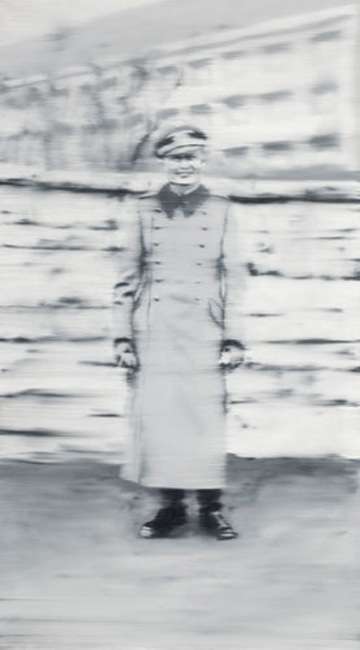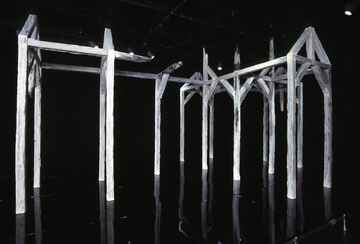[youtube:https://www.youtube.com/watch?v=w3OkEcdOtb0]
When I was a kid, Alice Cooper taught me everything I needed to know about art. So, ethics in art? For the most part I’m against it, but certain lines can be drawn. Tom Otterness shooting a dog? Not OK. Painting about Tom Otterness shooting a dog? OK. Probably not very interesting, but OK. Letting every single thought and feeling – no matter its depravity or provenance – through the floodgates is an essential ingredient in the making and viewing of art. An artist needs to have his or her id wide open and a viewer has to be similarly receptive. This means that some weird, unregulated dirt is going to find its way into the carburetor occasionally. Sometimes the final audience will see the evidence (every Mayhem record); sometimes it might be a little more hidden (every Richter painting).
Alice Cooper staggered onto the scene huffing the exhaust of the hippie vans. Peace was over. It might have been showbiz, but people were not happy with the ethics of singing about dead babies, junkie shoe salesmen, black magic, serial killers, necrophilia and confused 18-year-olds. That Alice was legitimized by hit records and a Salvador Dalí collaboration spoke to the dark truths he had hit upon underneath all the glitz and stage antics. Things are messy. Lines are always blurred, whether we like it or not. In our daily lives, we have the luxury of rejecting that notion. Artists — if they are going to speak the truth — do not. So, years later, it’s Alice I blame for my love of Richter’s Baader-Meinhof cycle of paintings and all things Black Metal.
Gerhard Richter’s work is all about failure and decay. Whether it’s human failure or the shortcomings of painting, some kind of bad gravity is always in full effect in the artist’s work. At its most beautiful, I still feel its menace. Conversely, at its most overtly menacing, I can see the beauty. In what is arguably considered one of Richter’s masterpiece series, the Baader-Meinhof cycle, the lines of ethics get even more blurry. The striking portrait of Uncle Rudi (1965) is a portrait of the artist’s uncle in his SS uniform. It’s difficult to look at the painting without seeing the mastery in Richter’s skills and his willingness to stare so directly into the history of his family and country. Uncle Rudi possesses clear internal poles of conflict (Nazis bad. Family good.). The Baader-Meinhof paintings crank up the blur because of the conflicted feelings of the painter’s fellow citizens and the murky details surrounding the death of Ulrike Meinhof. With this series, even from the greatest distance, we are immersed in gray.
On September 16, 2001, composer Karlheinz Stockhausen described the atrocities of September 11th as being “the biggest work of art there has ever been.” Most everybody I knew was horrified by the statement, except for a number of artists and writers I know. They were both horrified and understood what the composer was clumsily trying to say. When Mr. Stockhausen’s music was included in a program at Ground Zero in 2008, Bang on a Can’s David Lang defended the inclusion thusly: “Just by choosing the music that we love, without making this a foreground issue, we did end up choosing music that’s on both sides of this really complicated issue,” Mr. Lang said. “Maybe that’s the way it should be — the messy parts of human experience should get covered.”
And if there’s one messy mirror available to us, it’s Black Metal. The most extreme of the Heavy Metal genres (no slack accomplishment), Black Metal explores some of humanity’s darkest impulses and desires. It is a music that is violent, sad, ugly, and beautiful; often simultaneously. It taps into the shadowy side of life that modern culture seems so intent on obliterating — this, in spite of our near worship of war and ruin. All of our shiny lights are faded and bludgeoned to black. Even David Byrne has noticed the vein it so readily taps. In spite of its sometimes questionable approach to morality and ethics, Black Metal has been mined by artists from Matthew Barney to Glen Baldridge and Banks Violette.
Banks Violette’s Untitled sculpture at the Whitney in 2005 brought a couple of my worlds together, linking directly to a few of Norwegian Black Metal’s most notorious events: the mid-90’s church burnings and the brutal murder of Øystein Aarseth, aka Euronymous. From salt, Violette built a large-scale model of a burned-out church and placed it on a reflective black riser, making it both idol and star. Providing the soundtrack for the piece was Snorre Ruch, the convicted accomplice in the murder of Euronymous, a member of the band Mayhem. The sculpture was an extreme indictment of our present-day culture and what we worship, which has nothing to do with church or any semblance of fullness. It was a reflective well of bleak emptiness, and without Ruch’s involvement, I don’t know how Violette could have shown his vision to the viewer or, more accurately, how the artist would have allowed the viewer to see himself and the culture in which he so readily participates.
In the Times, Violette spoke of his decision to collaborate with Ruch. Writes Randy Kennedy:
“Snorre was the accomplice in the murder, and I, in a way, am his accomplice by having him do this music for a piece that refers to the act,” Mr. Violette said. “And then the viewer essentially becomes the third accomplice in viewing it.”
The ultimate effect, he hopes, “is a kind of sympathy for the devil in the mind of the viewers,” who should leave the Whitney asking themselves, at least subconsciously, a disturbing question: “‘I couldn’t possibly do that, could I?’ Well, probably you could.”
Like I said, all the doors need to be open. Even if it’s the back door. When I saw the piece, I spent a good amount of time with it because I wanted to hear the entire soundtrack. I moved around it, looking and listening. At one point the guard — who I’m assuming had spent hours, if not days, in the room — said to me tentatively, “Is it moving?” That’s the kind of power this work held. It was something true and essential, a destabilizing crack in the foundation. It was something we needed to know. And it came from a place where all the channels were open, for both the artist and his audience. If the idea of ethics had gotten in the way for either of us, I would have had just one reply: Let it burn.
Brent Burket is the blogger behind Heart as Arena, and is based in Brooklyn, New York.






Pingback: What’s Cookin at the Art21 Blog: A Weekly Index | Art21 Blog
Pingback: Flash Points Wrap-Up: Art For Life | Art21 Blog